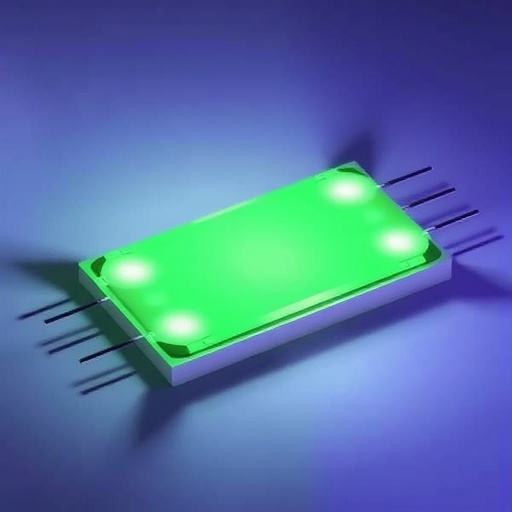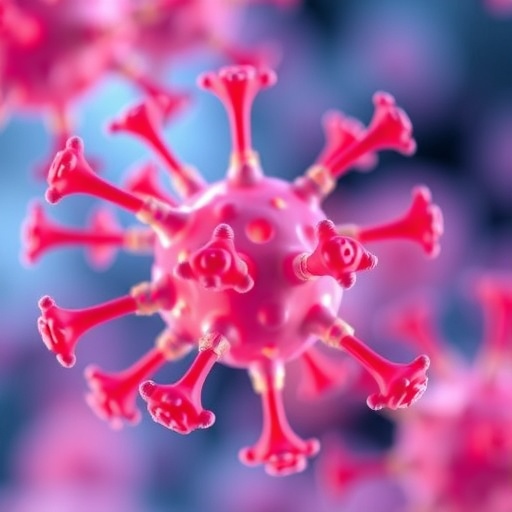In a groundbreaking advancement poised to redefine the future of display technology, researchers have achieved unprecedented efficiency in deep-blue light-emitting diodes (LEDs) using colloidal cesium lead bromide (CsPbBr3) nanoplatelets. This breakthrough directly addresses one of the most significant challenges in optoelectronics: producing stable, efficient, and color-pure deep-blue LEDs that comply with the stringent Rec.2020 color standard. The innovative work, recently published in Light: Science & Applications, showcases a novel pathway to meet and exceed the demanding technical requirements of next-generation high-definition displays, while simultaneously pushing the performance limits of perovskite nanomaterials.
Deep-blue LEDs have been a formidable target for researchers due to their intrinsic complexity. Achieving efficient emission in the deep-blue spectral region is notoriously difficult because of wide bandgap materials’ poor charge carrier dynamics, fast non-radiative recombination, and limited stability under operational conditions. Traditional semiconductors often suffer from low luminous efficiency, color instability, and short operational lifespan when scaled to commercial viability. CsPbBr3 perovskite materials, however, have emerged as promising candidates thanks to their remarkable optical properties, including high photoluminescence quantum yield, narrow emission bandwidth, and tunable bandgap. Yet, challenges in controlling their morphology and surface chemistry have restrained their practical applications—an obstacle effectively tackled by the researchers in this study.
The team employed cutting-edge synthetic techniques to fabricate colloidal CsPbBr3 nanoplatelets, ultra-thin nanostructures characterized by strong quantum confinement effects that precisely tune their emission wavelength into the coveted deep-blue range. These nanoplatelets feature an enhanced exciton binding energy and a reduced dielectric screening environment, enabling them to circumvent the efficiency roll-off that plagues bulk perovskite films. The colloidal approach also offers exceptional control over size distribution and crystalline quality, directly translating into improved device uniformity and reproducibility—key parameters for industry adoption.
What distinguishes this work is not only the synthesis of high-quality nanoplatelets but also their integration into functional LEDs exhibiting high external quantum efficiency (EQE) and brightness metrics that rival or surpass existing blue-emitting diodes. The devices demonstrated a remarkable balance of electrical and optical properties, with minimal efficiency droop even at high drive currents. This effect significantly enhances the operational stability and luminous efficacy of the LEDs—attributes essential for practical deployment in commercial displays and solid-state lighting applications.
Central to the performance enhancement is the meticulous surface passivation strategy employed by the researchers. Surface defects in perovskite nanocrystals typically act as non-radiative recombination centers, severely hampering device efficiency. By optimizing ligand chemistry and employing innovative passivation molecules tailored for CsPbBr3 nanoplatelets, the team minimized trap states and enhanced carrier lifetime without compromising charge injection. This precise interface engineering contributes directly to the devices’ superior photoluminescence and overall stability under continuous electrical excitation.
The newly developed LEDs also uniquely satisfy the Rec.2020 color standard, a comprehensive color gamut specification mandated for ultra-high-definition television (UHDTV) and emerging display technologies. Compliance with Rec.2020 ensures unparalleled color purity and saturation, allowing displays to render images with breathtaking realism and vividness. Achieving deep-blue emission with such fidelity has been a major bottleneck until now, and this work propels perovskite-based LEDs into the spotlight as serious contenders for commercial display solutions.
Beyond displays, the implications for lighting technology are equally profound. Deep-blue LEDs are vital components in phosphor-converted white LEDs, where their spectral qualities influence color rendering indices and energy efficiency. The low energy consumption and long operational lifetime exhibited by the CsPbBr3 nanoplatelet LEDs promise to contribute substantially to greener lighting solutions, reducing the carbon footprint of illumination technologies worldwide.
While perovskite materials have been extensively studied in photovoltaic and optoelectronic contexts, their integration into blue-emitting LEDs with stability and efficiency has remained elusive. This research addresses intrinsic material challenges and device-level optimization synergistically, showcasing a comprehensive approach from nanoscale engineering to macroscopic device fabrication. The success validates the potential of colloidal perovskite nanostructures as a versatile platform for advanced photonic devices.
The research group’s methodological innovations also include advanced characterization techniques, such as time-resolved photoluminescence and transient absorption spectroscopy, which elucidate the fundamental photophysical processes underpinning the improved device performance. These insights reveal suppressed non-radiative pathways and enhanced exciton dynamics resulting from the quantum-confined nanoplatelet architecture, shedding light on universal design guidelines for other perovskite compositions and device configurations.
Furthermore, the scalability of the synthetic process is emphasized, paving the way for large-area fabrication methods compatible with roll-to-roll coating and printing technologies. This attribute aligns well with industry demands for high-throughput, low-cost manufacturing of next-generation optoelectronic components, suggesting a viable route from laboratory prototype to commercial product.
Environmental stability, traditionally a significant hurdle for perovskite materials due to their sensitivity to moisture, oxygen, and heat, has also been addressed. The incorporation of robust encapsulation layers and chemical stabilization protocols within the devices prolongs their functional lifespan under ambient operating conditions, reinforcing their suitability for real-world applications.
Complementing the device performance, the researchers also demonstrate precise tuning of the emission wavelength by controlling the thickness of the nanoplatelets at the atomic scale, showcasing the exquisite tailoring possible within this material system. This capability permits the fine adjustment of spectral outputs to match stringent industry requirements for various display and lighting technologies, broadening the technology’s applicability.
The convergence of high efficiency, color purity, stability, and scalability embodied in these CsPbBr3 nanoplatelet LEDs represents a pivotal step toward overcoming the long-standing difficulties associated with deep-blue light emitters. This advancement opens exciting pathways for perovskite materials well beyond photovoltaic energy conversion, firmly establishing their role in the next wave of photonic devices.
Looking ahead, the research community anticipates integrating these LEDs with flexible substrates and sophisticated device architectures, pushing toward flexible displays, wearable electronics, and integrated photonic circuits. The unique properties of colloidal perovskite nanoplatelets could facilitate miniaturized light sources with unparalleled performance metrics.
This research exemplifies the synergy between materials chemistry, nanotechnology, and device engineering, highlighting how fundamental scientific insights can translate into technologies that redefine industry standards. The success empowers a new paradigm where quantum-confined perovskite nanostructures deliver on their long-promised potential as tunable, efficient, and vibrant optoelectronic emitters.
In summary, the achievement of efficient deep-blue LEDs based on colloidal CsPbBr3 nanoplatelets marks a transformative advance in the field of light emission. It overcomes significant material and device hurdles, meets the exacting Rec.2020 color standard, and charts a clear path toward commercial viability. This work heralds a new era of high-performance perovskite optoelectronics set to impact displays, lighting, and beyond with stunning visual fidelity and energy efficiency.
Article References:
Song, Y., Cao, S., Wang, Y. et al. Efficient deep-blue LEDs based on colloidal CsPbBr3 nanoplatelets meeting the Rec.2020 standard. Light Sci Appl 14, 336 (2025). https://doi.org/10.1038/s41377-025-02019-1
Image Credits: AI Generated
DOI: https://doi.org/10.1038/s41377-025-02019-1
Tags: cesium lead bromide nanoplateletscharge carrier dynamicscommercial viability of semiconductorsdeep-blue LEDsdisplay technology innovationshigh-efficiency light-emitting diodesluminous efficiency improvementsoptoelectronics advancementsperovskite nanomaterialsPhotoluminescence Quantum YieldRec.2020 color standardstable color-pure LEDs






